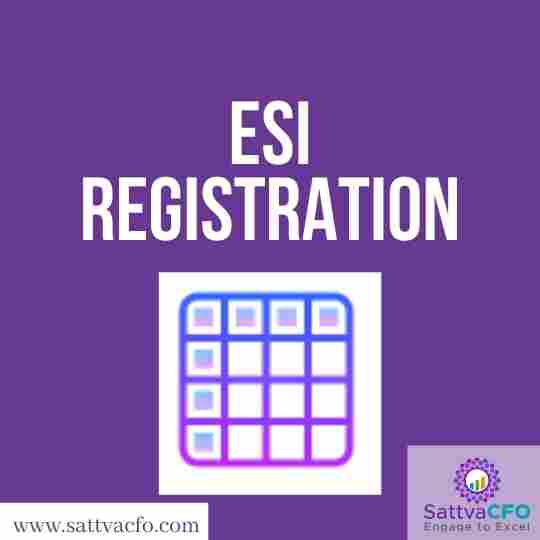ESI stands for Employee State Insurance managed by the Employee State Insurance Corporation, which is an autonomous body created by the law under the Ministry of Labour and Employment, Government of India. The Employees’ State Insurance programme is one of the most well-known social security programmes enacted by the Indian government following independence. The ESI Act of 1948 requires all qualifying businesses to register. Failure to enrol under the ESI scheme can result in legal action being taken against such businesses. As a result, businesses must ensure that they follow the ESI Act’s provisions in order to stay on the right side of the law.
ESI registration is mandatory once a company or any other entity employs 10 or more low-earning employees. According to the Act, any employee earning less than Rs. 15,000 per month needs to contribute 1.75% of their pay towards the ESI, while 4.75% will be contributed towards their ESI by the company. The ESI scheme provides tremendous benefits to the employees and has a large network of dispensaries and hospitals throughout the country for facilitating fast and efficient medical care.
ESI Registration
The Employees’ State Insurance programme is one of the most well-known social security programmes enacted by the Indian government following independence. The ESI Act of 1948 requires all qualifying businesses to register. Failure to enrol under the ESI scheme can result in legal action being taken against such businesses. As a result, businesses must ensure that they follow the ESI Act’s provisions in order to stay on the right side of the law.
What are the benefits of ESIC registration?
The benefits of registering under this scheme are as follows:
- Medical Benefits: Medical Care for self and family from day one of entering into insurable employment
- Sickness Benefits: 70% of average daily wages in cash during medical leave, up to 91 days in two consecutive benefit periods
- Maternity Benefits: 100% of average daily wages in cash up to 26 weeks in confinement and 6 weeks in case of miscarriage, during maternity leave, and 12 weeks for commissioning mother and adopting mother.
- Disablement Benefits: continuous monthly payment till injury lasts for temporary disablement and whole life for permanent disablement.
- Dependants’ Benefits: monthly payment apportioned among dependants in case of death due to employment injury.
- Unemployment Allowance: monthly cash allowance for a duration of a maximum of 24 months in case of involuntary loss of employment or permanent invalidity due to non-employment injury.
What is Employees’ State Insurance?
Employees’ State Insurance (ESI) is a self-funding social security and health insurance scheme for Indian workers that provides medical and disability benefits. It is administered by the Employees’ State Insurance Corporation (ESIC) under the Ministry of Labour and Employment and is governed by the ESI Act of 1948. The ESIC oversees the monies collected following the ESI Act’s norms and regulations.
When is ESI Registration Mandatory?
If a company or entity employs ten or more low-wage workers, ESI registration is required. According to the ESI Act, employees earning less than $15,000 per month must contribute 1.75 percent of their wages to the ESI. The remaining 4.75 percent of their ESI must be paid by the company or employer. Employees benefit greatly from the ESI scheme, which serves as India’s primary social security scheme. The system maintains a huge network of dispensaries and hospitals across India to facilitate quick and effective medical care.
What are the Documents Required for ESI Registration?
Under the ESI plan, the following documents are required:
- Depending on the kind of company, a registration certificate or a licence issued under the Shops and Establishments Act or the Factories Act Memorandum or Articles of Association for private limited companies, partnership deeds for LLPs, or Trust deeds
- All entities will receive a certificate of registration, and factories will be able to begin production.
- A detailed list of employees, together with their monthly compensation A list of the company’s directors, partners, and owners
- The business’s PAN card and proof of address are required.
- Bank statements of the organisation, along with proof of its start-up.
What Is the ESI Registration Procedure?
Applicants must first confirm that they have all of the necessary paperwork to complete the registration. Before beginning the registration procedure, business owners must gather all essential paperwork to avoid delays in processing. The registration process necessitates the submission of Form-1, an online application for enrolment by business owners. Businesses must download a PDF version of the form from the government’s official website and complete it before submitting it. Because the form has so many sections, it’s best to enlist the help of a specialist while registering your business for ESI.
Entities covered under ESIC
As per the government notification dated Sec 1(5) of the ESI Act, the following entities are covered:
- Shops
- Restaurants or Hotels are only engaged in sales.
- Cinemas
- Road Motor Transport Establishments;
- Newspaper establishments (which is not covered under the factory act)
- Private Educational Institutions
What are the documents required for ESIC Registration?
The documents required for the registration are –
- A registration certificate is obtained either under the:
- Factories Act
- Shops and Establishment Act
- Certificate of Registration in case of Company, and Partnership deed in case of a Partnership
- Memorandum of Association and Articles of Association of the Company
- A list of all the employees working in the Establishment
- PAN Card of the Business Entity as well as all the Employees working under the entity
- The compensation details of all the employees
- A cancelled cheque of the Bank Account of the Company
- List of Directors of the Company
- List of the Shareholders of the Company
- A register containing the attendance of the employees
After collecting all the above-mentioned documents, the following procedure is to be followed for the registration of the ESI:
- Form No – 1 (Employers Registration Form) is to be downloaded and filled.
- After downloading the PDF version of the form and filling it, it must be submitted on the ESIC website.
Steps involved for ESI Registration
- Once the documents are ready, the company can apply for registration by submitting the Employer’s Registration Form (Form-1).
- A PDF format of the form is available on the website. Fill in the form and submit it to ESIC for registration on the official website.
- Once verified, a registration number, a 17-digit unique identity will be provided to the organization. The ESI filings can be done once you receive the 17-digit number.
- Employees registered under the scheme get an ESI card after submitting a form with photographs and details of family members.
- Although the registration is permanent, and the number is valid for the company’s lifetime, any new changes, such as employee additions, need to be intimated to the ESI.
Documents for ESI Returns
The following documents must be maintained regularly for filing ESI returns.
1. Attendance register
2. Register for Form 6
3. Register of wages
4. Register of any accidents on the premises
5. Inspection book
6. Monthly challans and returns submitted for ESI
FAQ’s
What is the procedure for the registration of an employer?
Within 15 days of the ESI Act becoming relevant to their business or unit, an employer must file Form-1.
Is it mandatory for employers to register under the ESI?
Yes, all eligible employers must register their unit, factory, or institution.
As a result, it is the employer’s legal responsibility to register their unit/factory/establishment under the ESI Act within 15 days of the Act becoming effective.
What are the compliance requirements under the ESI Act?
Every employer who is subject to this Act is required to follow a set of rules. These guidelines outline how to submit monthly payments, file half-yearly returns, and notify authorities if the business’s activity, address, ownership, or management change.
In addition, registered businesses must adhere to compliance rules for the keeping of registers and records.
Are the benefits granted to the insured employees transferable?
No, under this Act, the right to receive any benefits is not transferable.
What is the ESI Code number?
If an employee’s wages exceed ₹15,000/- in a month, won’t they be covered anymore?
Every registered establishment is assigned an ESI Code number, which is a 17-digit unique identifying number. When the employer provides all of the relevant information to the ESIC portal, this number is generated. It can also be generated when the Social Security Officer sends you a survey report.
If an employee’s salaries, excluding overtime pay, surpass the Central Government’s wage cap, they will remain an employee until the conclusion of the contribution period. As a result, their contribution must be deducted and paid from their total earnings.
What is the time limit for the payment of the contribution?
Within 21 days of the final day of the month in which the contribution is due for any salary period, the contribution must be deposited into a bank officially authorised by the firm.
What is the mode of payment of the contributions?
The employer must submit a monthly contribution via the ESIC site, and the amount due is determined regularly.
The number of days worked, wage amount and due contribution are all additional facts that must be included.
On the generation of such a challan through the ESIC portals, the total amount of contribution for each month must be deposited in any SBI bank in cash, cheque, or demand draught.
Contributions can also be made online using SBI internet banking.
Why is the registration of an employee necessary?
The employee’s registration aids in identifying the employee and the provision of benefits under the Act, which are tied to the contributions paid by the employer on behalf of each of the covered employees.
What is an ESIC identity card?
After completing the registration process, the employer can issue a temporary identity certificate that includes the employee’s photo and is valid for three months.
This identification card is used to claim medical benefits at a dispensary or hospital and monetary benefits at an ESI branch office.
How can SattvaCFO help us?
Our ESI registration services can surely help you get through the cutthroat requirements of legal procedures. Though, we strictly follow the legal pathway; we ensure that your services are 100 percent taken care of. Our team at SattvaCFO, will guide you through the process and deal with all your burdens.




